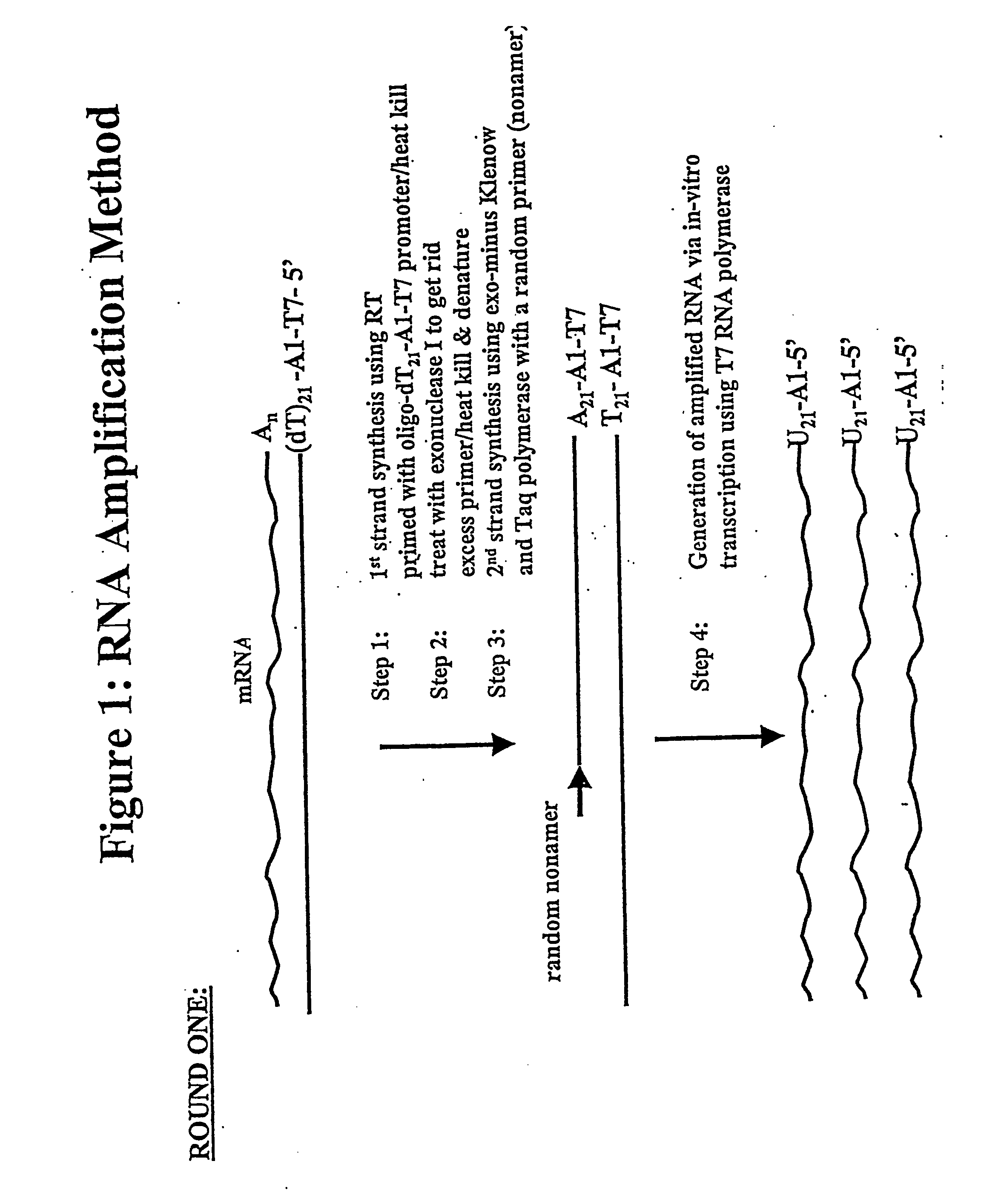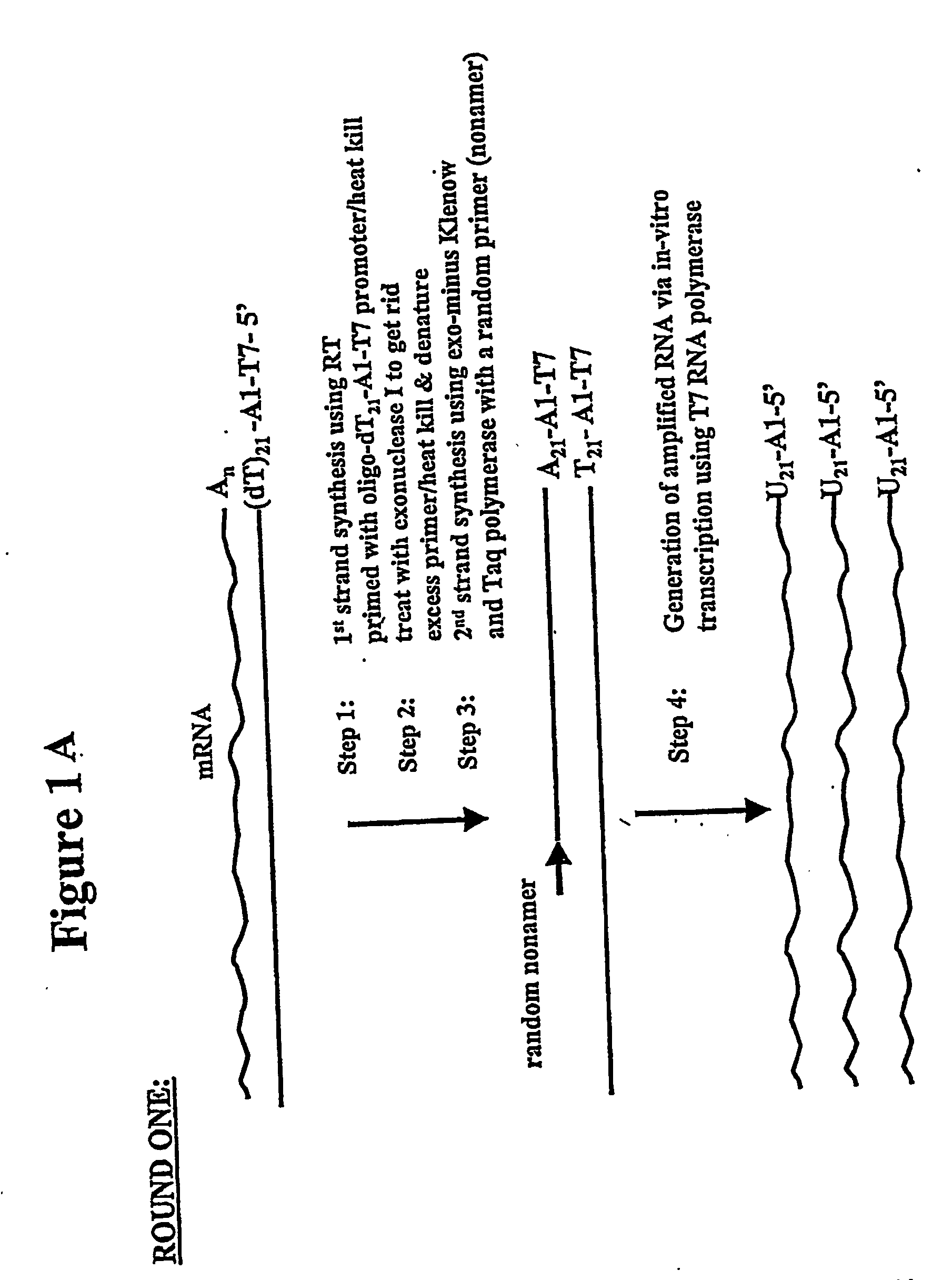Nucleic acid amplification
a nucleic acid and amplification technology, applied in the field of enzymatic amplification of nucleic acids, can solve the problems of difficult detection of low copy number nucleic acid targets, low sensitivity of methods when target nucleic acid amounts are low, and difficult detection of rare mrna species
- Summary
- Abstract
- Description
- Claims
- Application Information
AI Technical Summary
Benefits of technology
Problems solved by technology
Method used
Image
Examples
example 1
Transcription from T7 RNA Polymerase Promoter
[0171] In one general embodiment of the present invention, cDNA strands are synthesized from a collection of mRNAs using an oligonucleotide primer complex. If the target mRNA is the entire mRNA population, then the primer can be a polythymidylate region (e.g., about 5 to 25, preferably about 18-21 T residues), which will bind with the poly(A) tail present on the 3′ terminus of each mRNA. Alternatively, if only a preselected mRNA is to be amplified, then the primer will be substantially complementary to a section of the chosen mRNA, typically at the 3′ terminus. The promoter region is located upstream of the primer at its 5′ terminus in an orientation permitting transcription with respect to the mRNA population utilized. When the second cDNA strand is synthesized, the promoter sequence will be in correct orientation in that strand to initiate RNA synthesis using that second cDNA strand as a template. Preferably, the promoter region is der...
example 2
Source of Cell Samples and Isolation of Expressed Polynucleotides
[0176] Normalized cDNA library is prepared from one patient tumor tissue and cloned polynucleotides for spotting on microarrays are isolated from the library. Normal and tumor tissues from other patients are processed to generate amplified aRNA, which are, in turn, assessed for expression in microarrays. The objective of normalization is to generate a cDNA library in which all transcripts expressed in a particular cell type or tissue are equally represented (Weissman S M Mol Biol. Med. 4(3),133-143 (1987); Patanjali, et al. Proc. Natl. Acad. Sci. USA 88 (1991)), and therefore isolation of as few as 30,000 recombinant clones in an optimally normalized library may represent the entire gene expression repertoire of a cell, estimated to number 10,000 per cell.
[0177] Cells (˜100-500 cells) are harvested directly from frozen sections of tissue by laser capture microdissection (LCM, Arcturus Engineering Inc., Mountain View,...
example 3
[0178] cDNA probes are prepared from RNA amplified via the present invention from total RNA that has been extracted from normal and cancerous cells that are contained within a biopsy / surgical resection procured via laser capture microdissection (LCM, Arcturus Engineering Inc., Mountain View, Calif.). Fluorescently labeled cDNAs prepared from the tumor sample are compared to fluorescently labeled cDNAs prepared from normal cell sample. For example, the cDNA probes from normal cells are labeled with Cy3 fluorescent dye (green) and cDNA probes prepared from the tumor cells are labeled with Cy5 fluorescent dye (red).
[0179] The differential expression assay is performed by probing equal amounts of probes from tumor cells and normal cells of the same patient. The fluorescently labeled probes are hybridized to the array under conditions of high stringency (overnight at 42° C. in 50% formamide, 5×SSC, and 0.2% SDS). After hybridization, the array is washed at ...
PUM
| Property | Measurement | Unit |
|---|---|---|
| elution volume | aaaaa | aaaaa |
| elution volume | aaaaa | aaaaa |
| elution volume | aaaaa | aaaaa |
Abstract
Description
Claims
Application Information
 Login to View More
Login to View More - R&D
- Intellectual Property
- Life Sciences
- Materials
- Tech Scout
- Unparalleled Data Quality
- Higher Quality Content
- 60% Fewer Hallucinations
Browse by: Latest US Patents, China's latest patents, Technical Efficacy Thesaurus, Application Domain, Technology Topic, Popular Technical Reports.
© 2025 PatSnap. All rights reserved.Legal|Privacy policy|Modern Slavery Act Transparency Statement|Sitemap|About US| Contact US: help@patsnap.com



